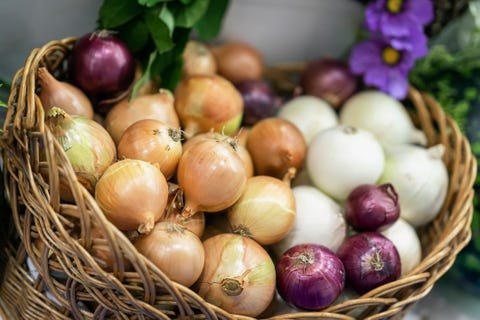Onions: A Growing Guide
9 min readOnions are one of the most indispensable and flavorful elements you can cook with. Experiment with raw onions in salads, add them to breads, toss them in soups (you can not go mistaken with a French onion recipe), or use them in casseroles. In addition, onions are recognised for featuring a selection of well being benefits—they can enhance your immune method, regulate your blood sugar ranges, and even support to retain your cholesterol below regulate.
Along with their medicinal homes and means to provide a lot more flavor to all types of foodstuff, they are also pretty straightforward to grow, as they can be tucked into spare corners and along the edges of back garden beds. If you might be curious about how to integrate them into your very own back garden, this is a beneficial primer on how to grow onions:
Varieties of onions:
Onions occur in a huge wide range of shapes, measurements, and shades. The white, yellow, or red bulbs selection in dimensions from tiny pickling onions to significant Spanish cultivars they can be world-, top-, or spindle-shaped.
Most types can be pulled younger as inexperienced onions, but there’s also a perennial bunching form called Allium fistulosum that is practically disease- and insect-evidence and produces outstanding scallions.
Each individual bulb of the multiplier or potato onion (A. cepa Aggregatum group) multiplies into a bulb cluster. So with each individual harvest, you can have bulbs to replant for a continual provide.
The Egyptian or top onion (A. cepa Proliferum group) produces a bulb cluster at the stop of a prolonged stem with a 2nd cluster commonly forming on top of the initially. It also has an underground bulb, which is typically too pungent to take in.
Other delicious crops include chives (A. schoenoprasum), garlic chives (A. tuberosum), and shallots (A. cepa Aggregatum group). Learn a lot more about expanding garlic here.
How to plant onions:
You can grow onions from transplants, sets, or seeds. You can acquire transplants, which are seedlings commenced in the current expanding time and sold in bunches, from nurseries or by means of the mail. They generally sort good bulbs around a brief interval of time (65 times or significantly less), but they are subject matter to ailments. The option of cultivars is to some degree minimal.
Sets are immature bulbs developed the former yr and offer you the most minimal cultivar choices. They’re the best to plant, the earliest to harvest, and the minimum susceptible to ailments. On the other hand, sets are also a lot more inclined to bolting (sending up a flower stalk prematurely) than are seedlings or transplants.
If you plant onion sets, the sets may well be discovered only as white, red, or yellow alternatively than by wide range title. Most growers prefer white sets for inexperienced onions. When shopping for sets, look for one/2-inch-diameter bulbs simply because they are the minimum likely to bolt.
Developing onions from seed gives the great benefit of a huge option in cultivars. The obstacle with beginning from seeds is that your crop will get up to four months to experienced. Gardeners in chilly-winter season spots will need to have to start out their onion seedlings indoors.
Always look at a cultivar’s working day-size need or advisable latitudes in advance of you acquire, simply because working day size has an effect on how and when onions sort bulbs. Brief-working day onions, this sort of as ‘Red Hamburger’, will sort bulbs as quickly as times arrive at ten to 12 hrs prolonged. They’re appropriate for southern latitudes only. Extended-working day types, like ‘Sweet Sandwich’ and ‘Southport Pink Globe’, need to have 13 to 16 hrs of summer season daylight in purchase to sort bulbs. They’re the form to grow in a lot more northern latitudes.
Onions like neat climate in the early part of their progress, so plant them in spring — other than in delicate-winter season spots, wherever onions are developed as a tumble or winter season crop. Typically talking, onions grow tops in neat climate and sort bulbs when the climate warms.
Plant onion seeds four to six months in advance of the final typical frost — or even earlier indoors or in a chilly body. When indoor seedlings are 2 to three inches tall, harden them off by exposing them to previously mentioned-freezing evening temperatures.
Outdoor, sow seeds thickly in rows about one/2 inch deep. You can attempt mixing in radish seeds both of those to mark the planted rows and as a trap crop to entice root maggots absent from the onions. Skinny seedlings to one inch aside, and skinny yet again in four months to 6 inches aside.
For transplants or sets, use a dibble to make planting holes 2 inches deep and four to 6 inches aside. Use the closer spacing if you plan to harvest some younger crops as inexperienced onions. For sets, open a furrow 2 inches deep and location the sets stem pointed stop up four to 6 inches aside, and then fill in the furrow. A single pound of sets will plant about a fifty-foot-prolonged row.
Recommendations on expanding onions:
The techniques you comply with will depend on the certain crop you might be expanding. In common, onions grow greatest if you retain them well weeded. Use a sharp hoe to slash off thieves pulling or digging weeds up can damage the onions’ shallow roots. The moment the soil has warmed, put down a mulch all around and involving the crops to discourage weeds and to keep dampness in the soil.
Dry problems result in bulbs to split, so water when essential to deliver at minimum one inch of water each week retain in brain that transplants demand a lot more water than sets do. Onions can not compete well with weeds, so it’s significant to immediate water suitable to the onion roots.
If you’ve ready your soil well, no fertilizing need to be essential. Always go straightforward on nitrogen, which can make lush tops at the expense of bulbs. New progress from the centre will cease when the bulbs start out forming.
Egyptian onions, chives, and shallots demand a little various cultivation from regular onions. Listed here are some suggestions for expanding these onion family members:
Egyptian Onions
Plant Egyptian onions in tumble in the course of the region harvest some in spring as inexperienced or bunching onions. In mid-summer season or tumble, miniature bulbs will sort at the stem suggestion, wherever most onions sort flowers. Decide these tiny bulbs when the tops start off to wilt and dry. Use them fresh or store in the freezer.
Chives
Plant chives and garlic chives in early spring in abundant soil. They will tolerate partial shade put prefer full sunshine. Seeds are extremely gradual to germinate, so most growers prefer to plant clump divisions, which you can harvest immediately after two months. Area the clumps, each of which need to incorporate about six bulbs, 8 inches aside.
Slice the grass-like, hollow tops commonly to keep output. The pom-pom-like lavender flowers are extremely beautiful, but usually get rid of the expended flowers to lessen the chance of rampant self-seeding. Dig up, divide, and replant each individual 3rd yr. Transplant to containers and move indoors for winter season harvests. Chives are just about as good frozen as they are fresh.
Shallots
Shallots, a preferred of French chefs, have a blue-inexperienced stem that is made use of when younger. In addition, it has a gray, angular, delicate-flavored bulb that is similar to the multiplying onion and is made use of like a delicate-flavored garlic. Shallots will tolerate all but the most acidic soils, but dig the earth deeply simply because the crops put down 8-inch-prolonged feeder roots. On the other hand, they have no lateral roots, so place them just 2 to three inches aside.
Propagate shallots by dividing bulb clusters. Each individual clove, in convert, will make four to eight new bulbs. In February or March, plant them one inch deep, hardly masking the suggestion of the clove. Retain the soil weed-free and a little moist, but do not fertilize. In early summer season, attract the soil absent from the bulbs. Harvest shallots as inexperienced onions at any time. Reducing the tops off around soil level will make new tops, and this sort of harvesting essentially will increase bulb output. Bulbs experienced in about five months. Pull and store like onions.
The suitable way to water onions:
To water onions competently, increase soaker hoses along the row close to the crops. Or open a tiny trench involving rows and fill it with water. This keeps the roots provided, when leaving most of the soil area dry, inhibiting weed seed germination.
Watch this video clip to study the basic actions for planting onions.
Problems to retain in brain:
You can generally assume a disease-and insect-free crop. A single doable pest is onion maggots: one/three-inch-prolonged white, legless larvae that journey in line from one bulb to the subsequent and burrow upwards to feed on the stems. To lessen the prospects of intensive damage, scatter-plant onions in the course of the back garden. (This interplanting can also advantage other back garden crops numerous Allium species will ward off pests—such as aphids, Japanese beetles, and carrot flies—from roses, lettuce, carrots, beets, parsnips, and associates of the cabbage spouse and children.) Putting a skinny layer of sand all around onion bulbs may well discourage adult flies from laying their eggs at the bottoms of the crops.
Hardly noticeable onion thrips are inclined to assault for the duration of incredibly hot, dry climate in July or August. They make deformed crops with silvery blotches on the leaves. Thrips overwinter in weeds, so lessen pest populations by holding the back garden thoroughly clean. Consider spreading a reflective mulch, this sort of as aluminum foil, involving rows to confuse the thrips. If you catch the trouble early, you can spray crops with Beauveria bassiana or spinosad to beat thrips. As a final vacation resort apply neem to regulate a severe infestation.
A disease called smut causes a inflammation or hardening of leaves just about the neck, which finally bursts and spills powdery black spores around the plant. Downy mildew, a purplish mildew, demonstrates up in midsummer for the duration of warm, humid climate. Onions are also subject matter to pink root, which causes roots to convert different shades and then shrivel, and neck rot, which causes tissues to sort a difficult, black crust. All these difficulties are induced by fungi in the soil and can be avoided by rotating crops and by doing the job humus into the onion bed to deliver good drainage.
Ideas on harvesting onions:
The moment onion tops convert yellow, use the back again of a rake to bend them around horizontally. This stops the sap from flowing to the stems and diverts the plant’s strength into maturing the bulb. A working day or so later, when the tops convert brown, pull or dig the bulbs on a sunny working day, and leave them to dry in the sunshine. Lay the tops of one row around the bulbs of one more to support protect against sunscald.
When the outer skins are completely dry, wipe off any soil and get rid of the tops—unless you intend to braid them. Retailer in a neat, dry location hang braided onions or those retained in mesh luggage in an airy place. Such dried bulbs will retain for about four months to one yr.
This content material is made and managed by a 3rd celebration, and imported on to this web site to support customers deliver their email addresses. You may well be equipped to obtain a lot more details about this and equivalent content material at piano.io
This commenting segment is made and managed by a 3rd celebration, and imported on to this web site. You may well be equipped to obtain a lot more details on their world wide web web-site.













.jpg)